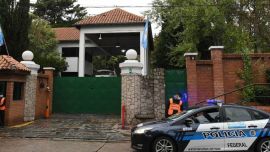A former naval academy that was turned into a secret death and torture camp during Argentina's 1976-1983 military dictatorship was added to UNESCO's World Heritage list on Tuesday, the first of a string of memorial sites that can have thorny political implications.
The ex-ESMA Navy Mechanics School, where thousands of people were detained, abused and killed, was a place where "the worst of state terrorism was expressed", President Alberto Fernandez posted on X (formerly Twitter).
"Let's continue to keep the memory alive," he added following the World Heritage Committee vote in the Saudi capital Riyadh.
While UNESCO has universalist aspirations, memorials are ripe for appropriation for political causes – especially where they touch on bloody events of the past involving multiple countries.
For instance, 2015's addition of key sites in Japan's Meiji-era (1868-1912) industrial revolution to the World Heritage list raised hackles in both South Korea and China.
People from both countries were deported and forced to work in Japan while under Tokyo's occupation of Korea from 1910-45 and China from 1932-45.
Only now, years later, are sites of memory back on UNESCO's agenda.
'Scars of history'
The sites under consideration this week "bear the scars of history", making them "a link between the past and the present that constructs the universal conscience of humanity," UNESCO chief Audrey Azoulay said last week as the committee meeting opened.
ESMA, the first site under consideration, was the site of a secret torture centre from 1976-1983.
More than 5,000 people were tortured and disappeared at ESMA, the Argentine government said in its application, calling it "material and physical testimony to human rights violations [that] serves as condemnation, proof and evidence of the acts of terrorism."
UNESCO's Heritage Committee will on Wednesday consider two other candidates with a bearing on conflict and violence.
One from Rwanda covers four memorials to the genocide against Tutsi people, more than a million of whom were slaughtered over 100 days in April-July 1994.
They include scenes of mass killings of tens of thousands in Nyamata, Murambi and Bisisero, as well as the Gisozi memorial complex in Kigali, which has since 1999 marked the deaths of 300,000 genocide victims in and around Rwanda's capital.
Rwanda's Culture Minister Jean Damascene Bizimana told AFP that the genocide against the Tutsi must be studied and taught to future generations, to allow "this tragedy to serve to promote peace" and hinder "denialism."
'Message of peace'
Also up for consideration on Wednesday are 139 World War I burial sites in France and Belgium.
"Respect for the dead is a universally shared value, which responds to the inhumanity of war by giving soldiers back an identity, a place in history and recognition for their sacrifice," said Patricia Miralles, France's junior minister for veterans.
The country's culture ministry said people from 130 countries had died in World War I, which claimed 10 million dead and maimed 20 million more.
It was the first time that war dead "were buried individually, when they could be identified".
Until now, the major memorial sites on UNESCO's World Heritage list had included the Auschwitz-Birkenau death camp built by Nazi Germany in occupied Poland, where up to 1.5 million people, many of them Jewish, were murdered.
Meanwhile in Hiroshima, the peace memorial site is the only building to have survived the 1945 explosion by the US of the first atomic bomb used in wartime.
A source familiar with UNESCO's workings told AFP that the three sites on this week's docket "have a universal message of peace" – despite current nuclear sabre-rattling by Russia in Ukraine, where Kyiv itself speaks of a "genocide" by Moscow against its people.
The source added that memory remains a touchy subject, with UNESCO for instance only "partially" recognising the genocide of up to 1.5 million Armenians in 1915-16 under the Ottoman Empire.
Although widely accepted by historians and officially recognised by around 30 countries, Ankara continues to reject the term "genocide" for the events.
related news
by Joris Fioriti, AFP






















Comments